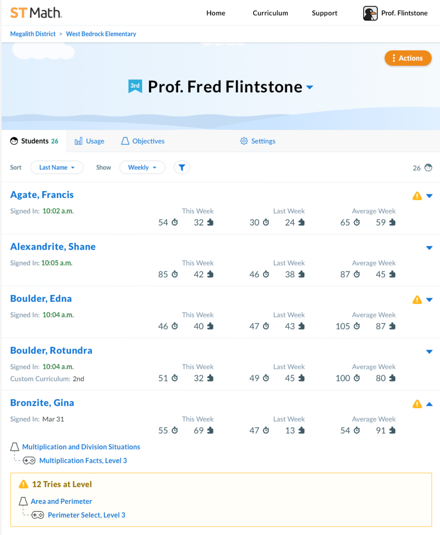
Billie Jo Lamoureaux is a K-5 math teacher at Morningside Community School in Pittsfield, Massachusetts. She's been using ST Math to provide engaging and differentiated instruction during this season of distance learning.
Last spring, the U.S. education system went completely virtual at unprecedented speed due to the coronavirus pandemic. The rapid transition left school administrators, teachers, and parents with little to no time to develop a unified plan for educating millions of students who would be unable to return to the classroom for the foreseeable future.
The first few months of the virtual learning experiment were chaotic for all of us. There were challenges with attendance. Some students didn’t own the proper hardware or have adequate internet access. And, teachers, already weathering budget cuts and potential layoffs, had to reinvent their lesson plans to fit the new digital format.
But through months of perseverance, we finally found our rhythm, using all our tools and talents to make distance learning work for everyone.

When I started researching distance learning, I naturally took to social media to hunt down a few examples from our wonderful ST Math teacher community. What I saw was inspiring! From hosting after school tutoring sessions on Facebook Live to parodying Mr. Rogers It's a Beautiful Day in the Neighborhood, I must say, I was a bit envious that I didn't have fun math lessons like these when I was in school.
With a few months of distance teaching under my belt, here are some useful tips that have helped me find my rhythm.
As a teacher to nearly 400 low-income students, I must constantly live in their shoes to stay effective. Even before the pandemic, my students faced significant learning obstacles ranging from reduced state funding to outdated technology. When my school announced that the rest of the academic year would be fully remote, I knew they would be hit particularly hard. That's when my colleagues and I sprang into action.
"Our number one priority was making distance learning their friend.”
To make the transition seamless, we compiled all the resources our students would need to adjust to learning at home. We made quick start guides on logging into Zoom, instructional outlines for daily activities, and video tutorials on getting started using ST Math. Our number one priority was making distance learning their friend. But first, we needed to understand that families are going through a lot right now, so we aimed to make the transition as turnkey as possible.
No one could have predicted the events of 2020. There were no contingency plans for a global pandemic or a list of remote teaching best practices to follow. We had to create them in real time, relying heavily on others for advice and support.
The next step I took was to make sure that everyone was on the same page. I started collaborating with my math department to make collective decisions on distance learning policies, procedures, and curriculum.

Having these group conversations early on uncovered shared challenges and possible solutions. There was a mutual feeling of togetherness, and we needed all the input we could get from other administrators and parents to make the remote learning format work for everyone.
My teacher group also worked together to create an incentive program to get students excited about using ST Math. We made virtual trophies as rewards for the number of puzzles completed and mailed home all kinds of JiJi swag like pencils and stickers.
Even when learning at home, math anxiety persists. The good news is that the ST Math program, combined with other collaboration tools, can help facilitate personalized instruction in a virtual environment.
For example, using Zoom and ST Math together lets me deliver one-on-one help without taking time away from instruction. I always devote part of my lesson to host virtual "puzzle talks,” which begin by reviewing the daily ST Math objective and a few practice puzzles to reinforce the concept. If students need extra help, they can enter their questions in the private chat window.
If a student continues to struggle, I can use Zoom to put them in their own breakout room to feel comfortable with explaining their thought process. I found this private question and answer format actually increased class participation since my kids could be honest about their learning journey. And if there were any connectivity issues, they could go back, replay, and complete ST Math lessons at their own pace.
ST Math helps me see how my students are progressing. Through the administrator dashboard, I can quickly identify clusters of students struggling with a particular concept.
Based on class results, I can address gaps in learning by using the ST Math's assignment feature. This new feature allows me to differentiate instruction and control the curriculum. I can place all students on the same content simultaneously or use the functionality to personalize instruction for each student.

With so much digital content out there, teachers often find themselves competing for attention. On top of explaining the material effectively, we now have to be entertainers. In short, whatever kids like, you have to adapt to it.
A simple way I learned to make lessons relevant is by making connections to pop culture. Relating math concepts to cartoon characters or trends on social media accesses their prior knowledge, putting the lesson in context while making it fun.
A fantastic example of connecting ST Math with pop culture was a Tik Tok project I assigned to reinforce the concept of telling time as students were working on that objective in ST Math. Students filmed themselves going through the lesson and sent them to me. Building these personal connections made my students take an active role in their learning journey. It also made for some funny viral videos!
It is understandable if a student's head is elsewhere. Be patient if things are not going perfectly. Remember that this is new for everyone, and getting the hang of distance learning takes time. If a student is late on an assignment or couldn't participate in a lesson because of connectivity issues, cut them some slack. You want to focus on building trust with your students early on and reassure them that they have an advocate in their corner.
Have any distance learning tips to share? Tell us about them in the comments section!

Billie Jo Lamoureaux is a K-5 Math teacher at Morningside Community School in Pittsfield, Massachusetts.
Comment